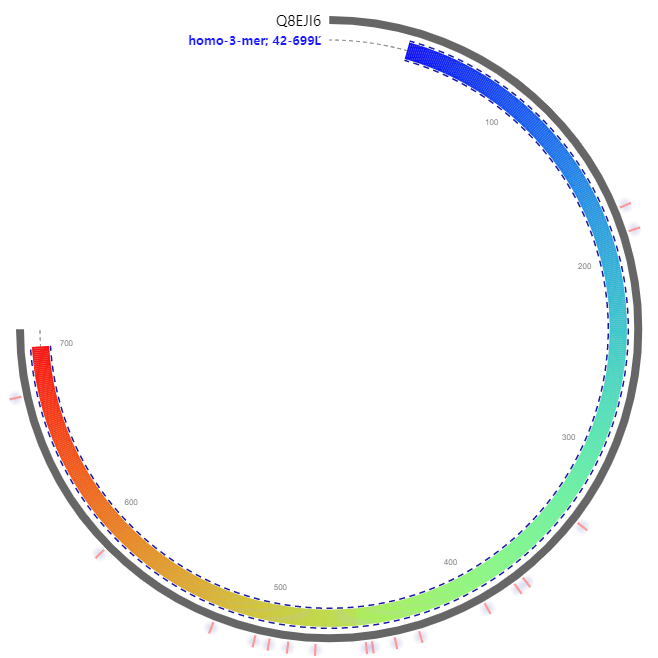Direct respiratory reduction of sulfite to sulfide.
MKRWKTKTALGVLFCLGSAVSATTIASDAKSDGKVVPGVGNKQQTHYTQDILANPKVSEN
LMEKSRGVKTLQDYIVQEQELFDFLFENHPVFKYDAEGRLKGTYKVSDRGEEYLHGGDSV
AYSKHSKEVNSTDGTAVRYSAYEDGQRPKALQYRLGAKSILDFPNKFVGPEKCGECHGPQ
YEKWRRSRHSKTIRFPGEHPEVDNDLKKPMYTTKDTSILPSGITPDAIYATVGTPRTKYG
FIDAYLVRGTYHVKDGLLKDGTGTMVAGGNQFSRGWAEWLTPEMAAKINKAIPSFPLKME
DFGTSGSHQWGMSSYGAKYEKEFLFQPASSYCEMCHSFKFDFQTKEEFFAALGNPKELQK
HTISKGITCEECHGAGGHLDGGIGGGMPSNCERCHQRFNFVEELAETPQGQEKLEYAFNV
KMKSSCPSCGTEGSQMFASAHYDKGMRCSTCHDPHEVTDGDWKSGITKPKIIKECTDCHT
AQAEIAKNTNTHSNQTCQSCHMPNMGSCENFTAIQFPDMAGFDNVRKSHMWKIDVDPLRK
TLNPPEGKSRDATTKGWTVAKDENGYNYLDLMWTCARTSASDHDVTENKGCHSQFQSELE
VGLHFEDQMEIYGEVQKWQKPVKDLFGQVLQGLQRIDKLLEVTQLPVDKKTEVLMLTDKA
QDVIKLVEADGSWGAHGPRYTQKRLDAALTYVQQAQAIIDGNGYNAKM719

| PMID | Title & Author | Abstract | Year | |
| 0 | 8347657 | The ferredoxin:sulphite reductase gene from Synechococcus PCC7942.Gisselmann G, Klausmeier P, Schwenn JD | The structural gene of the ferredoxin:sulphite reductase (EC 1.8.7.1) from the cyanobacterium Synechococcus PCC7942 (formerly 'Anacystis nidulans') was cloned and sequenced. The gene termed 'sir' was detected by heterologous Southern hybridisation with the structural gene cysI from Escherichia coli encoding the iron-sulphur haemoprotein of the NADPH:sulphite reductase. The open reading frame is comprised of 1875 bp encoding for a polypeptide of M(r) 70.028. The deduced amino acid sequence is 35.6% identical with the enterobacterial iron-sulphur haemoprotein. This putative fd-dependent sulphite reductase is only distantly related to the fd-dependent nitrite reductase (binary matching coefficient SAB: 0.23) or with the NADPH-sulphite reductase (SAB: 0.32). Highly conserved residues are found within the two Cys clusters forming the reactive Fe4S4-sirohaem centre of the enzyme. Expression of the si | |
| r gene using a fusion vector gave a single gene product which is immunologically related with the fd-sulphite reductase from the wild-type bacterium. | 1993 | |||
| 1 | 9661674 | Isolation and characterization of a gene for assimilatory sulfite reductase from Arabidopsis thaliana. Bork C, Schwenn JD, Hell R | Sulfite reductase (SIR) represents a key enzyme in sulfate assimilation in higher plants. The genomic DNA sequence of the sir gene from Arabidopsis thaliana including regulatory and structural regions was isolated and characterized. The sequence of a 6 kb fragment encoding SIR revealed a coding region of 2891 basepairs (bp) that consists of eight exons separated by seven introns between 83 and 139 bp in length. The transcription start point was determined 272 bp upstream of the translation start site. Southern analysis indicates a single locus for the sir gene that gives rise to a 2.4 (kb) mRNA in leaves and in roots. The promoter region was verified by functional expression of the gusA reporter gene in transgenic A. thaliana plants and was shown to provide correct expression in root and leaf. | 1998 |
| 2 | 21199252 | The octahaem SirA catalyses dissimilatory sulfite reduction in Shewanella oneidensis MR-1.Shirodkar S., Reed S., Romine M., Saffarini D. | Shewanella oneidensis MR-1 is a metal reducer that uses a large number of electron acceptors including thiosulfate, polysulfide and sulfite. The enzyme required for thiosulfate and polysulfide respiration has been recently identified, but the mechanisms of sulfite reduction remained unexplored. Analysis of MR-1 cultures grown anaerobically with sulfite suggested that the dissimilatory sulfite reductase catalyses six-electron reduction of sulfite to sulfide. Reduction of sulfite required menaquinones but was independent of the intermediate electron carrier CymA. Furthermore, the terminal sulfite reductase, SirA, was identified as an octahaem c cytochrome with an atypical haem binding site. The sulfite reductase of S. oneidensis MR-1 does not appear to be a sirohaem enzyme, but represents a new class of sulfite reductases. The gene that encodes SirA is located within a 10-gene locus that is predicted to encode a component of a specialized haem lyase, a menaquinone oxidase and copper transport proteins. This locus was identified in the genomes of several Shewanella species and appears to be linked to the ability of these organisms to reduce sulfite under anaerobic conditions. | 2011 |
Kern, M., Klotz, M.G., and Simon, J. (2011) The Wolinella succinogenes mcc gene cluster encodes an unconventional respiratory sulphite reduction system. Mol Microbiol 82: 1515–1530.